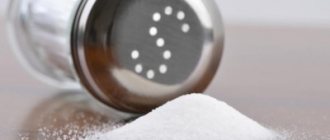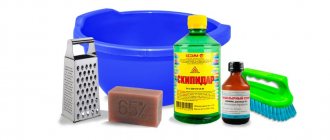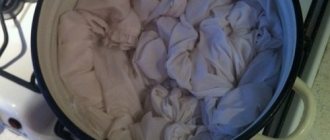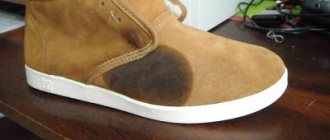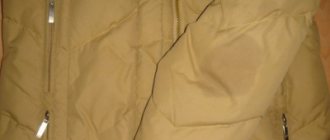Clothes and shoes stained in this thick dark substance are very difficult to clean. To remove fuel oil, you can use home recipes or special chemicals.
We will tell you further about how and with what you can remove fuel oil stains from clothes and shoes.
How to remove fresh?
Oil stains are among the most difficult to remove. It's easiest to remove a mark while it's fresh.
For initial processing you will need:
- laundry soap;
- water;
- brush;
- napkins.
Work order:
- Blot the fuel oil stain with a napkin or paper towel, trying to collect as much of the dark substance as possible. It is important to prevent it from being absorbed into the material.
- Moisten the affected area with water.
- Lather the brush with soap.
- Clean from the edges of the dirt towards the center. Rinse the brush in water as often as possible, lather it again, and continue cleaning.
- Wash the mark with clean water.
Only after all the dirt has been washed away can the item be washed by hand or in the washing machine.
By type of fabric and clothing
Shirt
To clean a fuel oil stain on a shirt, rub the stain with wet laundry or tar soap and rinse after an hour.
A white shirt, if it is not made of thin, delicate fabric, is soaked in a chlorine bleach solution.
Jeans, workwear, overalls, overalls
All these clothes are made of thick fabric. It is very difficult to remove fuel oil from it.
More aggressive means are needed here:
- petrol;
- White Spirit;
- car shampoo.
Newly planted spots can be rubbed with tar or laundry soap.
There is a method that is suitable for workers in auto repair shops and factories who often deal with petroleum products. To prepare the cleanser you will need:
- grate a bar of laundry soap;
- a glass of caustic soda;
- liquid stationery glue – 100 ml;
- hot water – 10 l.
Mix all ingredients in a large container. Put a robe or overalls there and wait a few hours. Wash the item in the washing machine.
Sheepskin coats, coats
The following products are suitable for this outerwear:
- aviation gasoline;
- ammonia;
- White spirit solvent;
- car shampoo and other car products against grease and oil stains.
Bolognese jacket, down jacket
If a down jacket or jacket is stained with fuel oil, the following will help clean it:
- dishwashing gels;
- solvents with toluene;
- essential oils (eucalyptus, fir).
You need to cover the stain with the product, then use a dry cotton swab to remove the dirt. Wash things in the washing machine.
Shoes, boots, shoes, sneakers
Fuel oil is difficult to wash off from shoes made of suede, dermantin, leather or fabric.
Use the following tools:
- petrol;
- car shampoo;
- White Spirit;
- toluene.
To clean, soak cotton wool or a piece of cloth in one of the products and rub the dirt. Repeat if necessary. For leather shoes, use chalk.
How to remove using folk remedies?
It is no longer possible to wipe off a dried fuel oil stain with soap and water. Working with old stains takes longer, is more difficult , and the result is not guaranteed.
Ammonia
Ammonia purchased at a pharmacy is suitable for treating stains and splashes from fuel oil. A sponge soaked in ammonia is applied to the stain and left to act for 60 minutes. After this, the item is washed.
Tar soap
Tar soap can be purchased in the department of household chemicals . It is produced using birch tar. For processing you will need a brush. It is moistened in water and soaped. As the stain is treated, the brush is washed from time to time and soaped again.
Caustic soda
Caustic soda is a technical product based on alkali. It is used in everyday life to clean various surfaces from difficult stains.
This product is also suitable for fuel oil, but only if thick workwear and not delicate fabrics are treated.
Application procedure for fresh traces of fuel oil:
- cover the stain with baking soda;
- leave for half an hour;
- brush off the powder;
- wash the product.
Application procedure for removing old dirt:
- Prepare a solution in a basin - for every liter of water - a couple of tablespoons of caustic soda.
- Soak the soiled item in the prepared solution.
- Leave for 1.5-2 hours.
- Rinse.
- Wash.
Refined gasoline
Refined gasoline can be used as a solvent . Moisten a napkin in the prepared product and moisten the area with the stain. After exposure, when the fuel oil begins to separate, use a brush to clean from the edges of the contamination to the center.
Turpentine
Turpentine, which is used as a solvent for oil paints, will also help with oil stains.
To increase efficiency, it is better to mix this substance in equal parts with ammonia and use it sparingly, only on the contaminated area.
Safety precautions
An item contaminated with fuel oil can be hopelessly damaged if the stain is removed incorrectly, so when cleaning clothes you should follow some important recommendations.
First of all, you need to check how the chosen product will affect the fabric. Some substances can corrode fibers or change the color of the fabric, and it will no longer be possible to correct this. Therefore, you need to apply the stain-removing composition to a small, inconspicuous area of the fabric and wait a while. If the clothing is not damaged, the substance can be safely used in the area of the fuel oil stain.
It should be remembered that alkaline solvents (gasoline, acetone) are not suitable for cleaning silk and wool, and velor and viscose deteriorate from contact with acids (ammonia, turpentine).
When scrubbing a stain, you need to move from the edges to the center so as not to smear the dirt even more. It is recommended to moisten the contours of the contamination with water, and place cloth or paper on the reverse side.
Since when washing clothes stained with fuel oil grease, caustic substances are often used that can cause chemical burns to the skin and mucous membranes, you need to carry out the cleaning procedure with gloves and a gauze mask, carefully ensuring that the product used does not get into your mouth and eyes.
It is necessary to clean the item manually and only after that send it to automatic washing, otherwise the fuel oil will remain on the parts of the washing machine, and subsequently even clean laundry will acquire the characteristic smell of industrial lubricant.
Application of special compounds
To remove stains left by fuel oil, only serious, targeted stain removers capable of dissolving petroleum products should be used.
Dr.Beckmann Lubricant and bitumen
Concentrated stain remover is available in small 50 ml containers. The drug is suitable for removing stubborn stains left by:
- machine oil,
- lubricant,
- bitumen.
The product has been tested by dermatologists and can be used to tidy up not only adult, but also children's clothing. The stain remover is suitable for white and colored fabrics. The drug is applied to the stained area and left until the stain dissolves and its particles separate. After this, the item is cleaned and washed.
The price at points of sale is mainly up to 200 rubles. Read reviews here and here.
Duty oil
The product is intended to remove stains from lubricants and various technical fluids, including fuel oil. At its core, it is a low-foam, alkali-based detergent with a disinfecting effect. A product for removing technical oils is produced in the Russian Federation. Price for 5 liters – from 1000 rubles.
Pro-Brite Axel-6 Oil & Grease Remover
The product in spray form is intended to remove marks from industrial oils from textiles and hard surfaces. It is convenient to spray the stain remover onto the area with the stain and treat it with a brush or napkin. The product can also be used for greasy stains of plant and animal origin. The average price is up to 350 rubles.
Useful tips
- For optimal results, clean the stain from the edges to the center. This is the only way to prevent divorces from occurring.
- Paper towels are very convenient, they are great for drying your hands, and you don’t need to wash them.
- It’s easy to wash fuel oil off your hands if you use a well-known dish soap.
- If the clothing contains artificial fibers, you must first experiment with the solvent on the inseam area. This way you can determine whether the item will retain its original appearance after intensive cleaning.
How to wash colored clothes?
Oil marks may leave streaks even after the stain has been removed. Products that have a brightening effect help remove such complex stains from white items.
If the composition of the tissue allows, even aggressive drugs can be used. In this case, it is better to carry out subsequent washing with powder intended for washing white clothes, supplementing it with a powder enhancer.
You need to be careful with colored things . In addition to effectively removing the dirt itself, aggressive agents can damage bright colors.
To avoid such a nuisance, it is better to test the selected product on an inconspicuous area. And only after making sure that it is safe, proceed to treating the stains. If the dye is not permanent, it is better to take the item to the dry cleaner for professional treatment.
Old stains
There are 2 ways to remove old stains. The choice of method depends on the type of fabric.
Removing old stains with a chemical:
- Old blots from fuel oil and other lubricants can be cleaned with technical gasoline, benzene or trichlorethylene. You can also use a special stain remover “Dr. Beckmann" (50 ml) for tar stains, wax, grease or "Dr. Beckmann" for grease and oil stains (50 ml), available in household chemical stores.
- After cleaning, rinse the stain remover thoroughly with water, wash, and leave to dry.
You can remove old stains with laundry soap (72%):
- Wet the contaminated area with warm water.
- Wipe with soap, lather with a brush, rub, gradually removing dirt with a damp cloth or sponge.
- Repeat the process several times as needed.
- Rinse the area to be treated thoroughly with water or wash it and leave to dry.
Features of removing traces from different materials
The type of fabric from which the clothes are made largely influences the rules for caring for the product , including methods of action when removing stains. When working with fuel oil, special work clothing is recommended. Dense fabrics used for overalls withstand solvents, even aggressive ones.
Difficulties in removing fuel oil from clothes arise when everyday clothes are soiled. Basic information about how to care for an item can be found by examining the label.
Jeans
Most often, jeans suffer from fuel oil and other petrochemical products. To clean these pants, you can use store-bought stain removers and home remedies .
One of the main requirements is that the selected drug should not discolor the color. Therefore, products with chlorine and bleaches are immediately prohibited.
It is advisable to immediately wash denim trousers that have just been soiled using soap or dish gel.
Can also be used:
- refined gasoline;
- auto cosmetics;
- solvents, etc.
Jackets
Products that dissolve industrial fats will help remove traces of fuel oil from bologna. It could even be regular dishwashing detergent or solvents. After treatment, the jacket will need to be washed, otherwise smudges and stains will remain on its surface.
Wool, silk, synthetics
If clothes made of wool, silk or synthetics have been damaged by fuel oil, solvents should not be used . Harsh chemicals can seriously damage fabric.
Preparations containing alcohol or ammonia will help to overcome stains on products made from such fabric. You can also use stain removers that are gentle on fabric fibers and are guaranteed not to spoil the item.
Workwear
Fuel oil can be removed from work clothes in almost any way. Even regular laundry detergents can be effective if you rub the dirt with a brush and leave it to act on the applied product.
But even on such durable clothes, targeted stain removers will give a much greater effect . Before using a new stain remover, it is best to test its effect on an inconspicuous area.
Use of household chemicals
You can wipe off traces of fuel oil using household chemicals. Kitchen cleaning products do a good job of removing fresh stains. For example, Silit Beng Antifat, Mister Muscle for the kitchen and others.
They contain substances that can dissolve even burnt fat. However, such products can damage the fabric, so be sure to first test the effect in an inconspicuous place.
Car shampoos
Household chemicals include car shampoos. You can use body wash to clean oil stains on clothes. Apply the shampoo to the clothes for half an hour, and then wash the item as usual.
How to clean it from shoes?
To remove fuel oil stains from shoes, you need to analyze what material the pair is made of. Just as with clothing, you need to act without delay.
Fabric
Textile sneakers remove stains using the same principle as clothing . Taking into account the type of upper fabric, a suitable stain remover is selected. After the stains are removed, the sneakers are washed.
Suede
Shoes and clothes made of suede that have been damaged by fuel oil are difficult to clean due to the capriciousness of the material. Such products cannot be washed.
You can use the following approach to remove fresh stains:
- Sprinkle starch or talcum powder directly onto the stain.
- Leave the item for a few minutes so that the dirt is partially absorbed into the powder.
- Shake off the powder.
- Clean the suede with a special brush.
- Apply a special suede care product.
Leather
It is advisable to remove any dirt that gets on your shoes as quickly as possible. Talc or chalk will help to collect the bulk of the fuel oil. The powder is poured onto the stain and rubbed in effortlessly using a brush. It is better to leave the couple in this form for a day. After a day, the chalk is shaken off, and the surface of the skin is wiped with a sponge soaked in glycerin.
Types of funds
To safely remove fuel oil from clothes at home, you should carefully choose your products. Aggressive solvents are used for complex and old stains, while more gentle products will help remove fresh ones.
Aggressive
- Gasoline (diesel, kerosene). Used to remove oil stains of any complexity. Refined gasoline, which is sold in hardware stores, will do. The usual one from a gas station will not have any effect. Please note that gasoline can remove paint from fabric fibers.
- Acetone. The solvent removes fuel oil with a bang, but the substances included in the composition can corrode synthetic fabrics. It is not recommended to scrub fuel oil from dark clothes with acetone to avoid the formation of white stains.
- White Spirit. It practically leaves no streaks on the fabric and does not damage the color of fabrics.
- Toluene. A very toxic but effective product for removing fuel oil stains from shoes or clothing. It is difficult to find in its pure form; it is usually included in other chemical solvents.
- Cleaning products for cars. Car shampoo will help remove fuel oil stains from clothing. Additives will have a gentle effect on colored fabrics.
Remember that solvents are dangerous toxic substances. Use rubber gloves and protect your respiratory system. After use, ventilate the room for at least 30 minutes.
Gentle
- Household detergents. Fairy dishwasher or fabric stain remover will handle fresh stains. For old stains, try the procedure several times.
- Tar soap. Simply rub soap on the stain and leave for a couple of hours. Do not wash the fabric - with strong friction, the resin substances will penetrate deeper into the structure of the fabric and it will not be possible to completely remove the stain.
- Essential oil. Eucalyptus and fir oils will not harm the texture or color of clothing due to their natural ingredients. Solvent properties are less pronounced, so repeat the procedure several times.
- Butter and margarine. Capable of destroying the resinous constitution of fuel oil and removing contaminants. Remaining oil traces can be removed with ordinary detergents.
- Heat treatment. With the help of napkins and an iron, it is possible to remove a recently applied stain. High temperature returns the fuel oil to a viscous state and it is absorbed into a paper or cloth napkin.
To remove stains from light-colored clothing, use a resin-dissolving mixture recipe. The method has collected a lot of positive reviews on online forums. Combine turpentine, white kaolin clay or baking soda, potato starch and ammonia in equal proportions. Mix everything until you obtain a homogeneous paste. The mixture will remove fresh fuel oil contamination the first time.
What products should not be used
Using traditional stain removers is a waste of time and effort. They will not cope with fuel oil:
- lemon acid;
- hydrogen peroxide;
- baking soda;
- salt.
These substances are not able to dissolve the resins that underlie fuel oil.
Did you know that eucalyptus oil is a good solvent for petroleum products?
Not really
Cleaning our hands
If a person repaired a car, then his hands will definitely get dirty. What to do in such a situation? How to wash your hands from fuel oil? There are also many proven methods, namely:
Using washing powder
You need to apply a small amount of it to the skin and rub the contaminated area well. After this, wash your hands with warm water. The procedure continues until the spots disappear completely. It's worth noting that the powder (and cleanser if you choose to use it) is very drying to the skin. Therefore, after such procedures it is advisable to apply moisturizers;
Starch, soda, ammonia and turpentine
The first two components (starch and soda) are taken in two tablespoons. Liquid components (ammonia and turpentine) are added one teaspoon at a time. Everything is thoroughly mixed and applied to your hands. You need to wait until the product dries completely and wash it off with water and laundry soap.
Coffee grounds
The product is applied to the contaminated area of skin and rubbed thoroughly. After this, rinse off with warm water. The substances contained in coffee have a good absorbent effect, which helps to cope with the pollutant;
Elderberries
You can use elderberries to scrub oil off your hands. They rub their hands with it like soap. You can also use currants and gooseberries for these purposes.
There are many ways to remove fuel oil from your hands. But it is worth noting that this substance is quite corrosive. If you often work with equipment, you won’t be able to wash your hands clean. Therefore, it is best to use gloves.
An old trace does not mean eternal
Heavy stains of the same nature are not easy to clean. This usually requires more effective and aggressive formulations. But under no circumstances should they be used on thin and delicate fabrics. Therefore, the use of such solvents should be approached with caution, so as not only not to spoil the fabric, but also for your own safety:
- Gasoline or diesel fuel is an effective way to combat fuel oil pollution of any age. The only condition is that only pure gasoline is suitable for such purposes (it can be bought at hardware stores). The regular one, which is used to refuel vehicles, is not so effective. The treatment process is standard: a piece of thick fabric or paper folded in several layers is placed under the stain. Using a cotton swab well soaked in gasoline, carefully wipe the oil area, changing it as it becomes dirty. After this, the item is soaked in warm water with washing powder and stain remover, washed by hand and rinsed several times. Then again in the car, using the “For heavily soiled items” mode. When the overalls are smeared, they are completely soaked in gasoline for 30-40 minutes, and then treated in the manner described above.
Do you wash your shoes in the machine?Oh yes! No
- Toluene is the most effective and most toxic composition. It is practically not sold in its pure form, but is often a component of many paint and varnish solvents. They process fuel oil traces in the same manner as with gasoline. It will clean your down jacket well from stains.
- Car wash products - they themselves involve the fight against serious pollution. You can buy such shampoos at any store that sells spare parts and car accessories. Cleaning with them is carried out according to the standard: the detergent composition is applied to the stain, rubbed in, and after half an hour the item is soaked, washed by hand and finally in SMA with the addition of powder with a stain remover.
Car shampoo
How not to wash fuel oil
It is difficult to wipe off fuel oil with cold liquids. Keep them at room temperature before using. Regular ethyl alcohol will not give results, nor will products based on it. After treating the stain, wash your clothes separately from other items, otherwise they may develop an odor. Of the soap products, only those that are aimed at removing dense fat are suitable. Shampoos and toilet soap will not bring results.
If you have stained a light down jacket or a silk blouse and you are not sure that you can handle it yourself, send the item to the dry cleaner. The craftsmen there use special compounds, and they also have extensive experience in dealing with any kind of contamination.
Removing fuel oil from shoes
The choice of method for removing blots from shoes depends on the material from which they are made.
Leather shoes
Place a small patch used for repairing bicycle tires on the grease stain. Leave on overnight, then remove. To restore shine and color, use a suitable shoe cream (spray). On clean leather shoes, fuel oil will not be absorbed; just wipe the area with a paper towel.
Removing fuel oil from shoes
Suede, other materials
To clean suede shoes and other materials (sneakers, ballet shoes, etc.), first thoroughly absorb the remaining fuel oil with a paper napkin, then wipe:
- suede - with a special cleaner for suede shoes;
- other materials - hand cream or just a soft brush.
Remove stubborn stains with a piece of white cotton wool moistened with technical gasoline. In a hidden place, first test the effect of gasoline to see if it discolors the material.
Furniture cleaning
other methods
Do you need to clean overalls, work clothes, textiles from difficult-to-remove stains from fuel oil and other lubricants? The following tips will help you with this and can help you get rid of even the most stubborn stains.
Machine washable
Industrial degreaser
Never soak clothing contaminated with heating oil or oil in cold water. Fatty substances will be fixed in fabric fibers due to chemical properties!
Cleansing procedure:
- Apply a commercial degreaser to a sponge soaked in hot water. You can use a general-purpose degreaser, available in household chemical stores; Before use, read the instructions and make sure that the substance is suitable for the item being treated.
- Test the product in an inconspicuous place to avoid discoloration of the fabric.
- Using a sponge, carefully treat the blot, leave the substance to act for 5 minutes (or follow the instructions).
- Then put the clothes in the washing machine, add a good stain remover in addition to the washing powder you usually use.
- It is recommended to wash at 60°C. But if the fabric from which the clothes are made requires a gentle temperature regime (not higher than 30-40°C), it is advisable to add a little dishwashing detergent to the drum.
ARTICLE FOR YOU
How and with what to wash and remove stains and sweat odors from clothes and linen
Treating stains with dishwasher
Dishwashing liquid
Dishwashing detergent is good at removing grease from kitchen utensils, so it can be used to remove fuel oil stains from clothes. It contains special substances that absorb fat. Apply a little product to the dirty area and rub with a small sponge or your hands.
If the blot is large and has penetrated to the wrong side, apply the product to both sides of the item and wipe again. Leave it to act for a while, then rinse with water and wash.
You can use vinegar water to rinse dish soap - it is more effective than plain water. Mix vinegar with water (1:2), rinse the stain in the solution. Vinegar can be replaced with lemon juice or acid. After this procedure, place the clothes in the washing machine, select a program according to the instructions on the label.
Starch + turpentine + ammonia + white clay
Mix these components thoroughly, apply the resulting suspension to the stain, and a little to clean surroundings. After drying, wash.
Stain removers Vanish
"Vanish"
If the fuel oil has not had time to penetrate the fabric fibers (up to 30 minutes after contamination), you can use a household cleaner such as Vanish. Apply it for 1-2 hours, then wash the item, again adding “Vanish” to the washing machine.
Car shampoo
The next effective remedy is shampoo used when washing cars (it can be bought at the automobile market). Apply shampoo to the blot for 30 minutes, then wash - by hand or in the machine - using regular powder.
Car shampoos
Baking powder, baking soda
These 2 powders, found in almost every kitchen, can be excellent helpers in removing fuel oil from things. Mix the powder with a little water. Apply the paste to the stain and leave to act (30-60 minutes). Then rinse under running water and wash as usual.
Starch
Sprinkle starch onto the greasy area and leave for at least 15 minutes. Then scrape or rinse and wash the garment.
Baby powder
Baby powder
Use the powder in the same way as starch, but leave it on for at least 30 minutes.
WD-40, lighter filler
Spray a small amount of WD-40 or lighter fluid onto the stain and let it sit for about 20 minutes. Then rinse the dirty area in warm water and wash.
Bile soap
Bile soap acts as a classic stain remover - it removes lubricants from most surfaces. Just rub the stain with it and rinse with water. To improve the result, you can use a brush; it will ensure better penetration of soap between the fibers.
ARTICLE FOR YOU
How and with what to wash and remove iodine stains from clothes and linen
Bile soap for removing stains
Salt
To avoid the use of chemicals (which is important when cleaning baby clothes), try classic table salt. Apply a little salt to fresh stains (for old stains it will be ineffective), moisten with water, and rub with your hands. Wash in the washing machine, adding regular powder.
Artificial sweetener
A true master of the common cleaning products category, this artificial sweetener is suitable for treating any greasy stain. If fuel oil gets on your clothing or other surface, immediately wipe the area with an artificial sweetener that absorbs grease and moisture.
This method only works for fresh stains, but if you notice the stain in time, you can easily save your favorite shirt.
Shaving foam
Shaving foam
Take some shaving foam (not gel) into your hands and gently rub into the dirty area. Wait until the foam is completely absorbed and dry, then place the item in the washing machine using the longest program possible.
Butter
Paradoxically, you can remove fuel oil well using heavy-duty butter. Lubricate dirty areas, leave for a while, then scrape off the oil, treat the area with a small amount of technical gasoline or other grease solvent.
Butter





